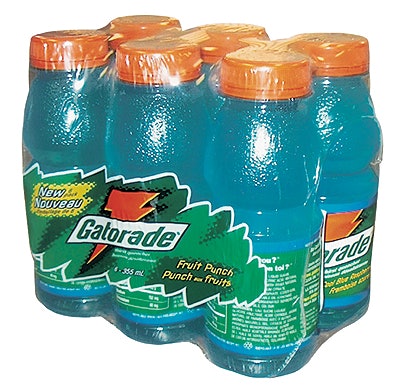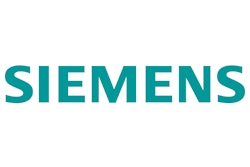Gatorade is designed to appeal to athletes who can run fast or make quick moves. Quick moves are rarely the province of major manufacturers such as Quaker/Tropicana/Gatorade, the Peterborough, Ontario, Canada-based division of Quaker Oats Co. In bringing its new Kids Pack to market, QTG has shown it learned a few quick cuts, perhaps from Toronto’s NBA star Vince Carter.
The pivot man in the Kids Pack project was QTG’s Mark Knechtel, manager of the supply chain for beverages. “The supply chain that I look after had been challenged,” he told Packaging World. “Marketing had a concept they wanted to bring out, so we found a group of partners that played a great role in making the Kids Pack a big success.”
The partners Knechtel is referring to include Over The Rainbow Packaging Services (Brampton, Ontario, Canada), a repackaging company; Damark Packaging (Scarborough, Ontario, Canada), which engineered and built a first-of-its-kind shrink wrapping line with print registration; film supplier Pliant Corp. (Schaumburg, IL); and converter Custom Medallion (Mississauga, Ontario, Canada). What made this effort so unusual is that it had to be ready for production in just four months!
The Kids Pack is an unsupported, shrink-wrapped six-pack of 12-oz (355 mL) PET bottles of Gatorade in either Fruit Punch or Cool Blue Raspberry flavors. While Gatorade’s traditional target market is young men aged 18 to 24, Kids Pack is geared for younger consumers. The new multipack was designed to introduce the product to children as young as six years old. “This is a strategic play to keep the isotonic category expanding and growing,” Knechtel says.
“If we were going to produce three to four million cases per year, we would have bought a bigger system,” he says. “For the Kids Pack launch with its smaller volume, what we had to do was get really creative.”
Outsourcing all production
In the end, QTG purchased a complete new shrink-wrapping line from Damark that was installed at and is operated by Over The Rainbow (OTR). At the time, OTR had no other use for this line, beyond the Kids Pack. “The machinery would be exclusive to our product. So we felt we had to make the capital investment,” Knechtel says. “The other issue was timing. We took a bit of a risk, not knowing how well this product would sell.”
Knechtel explains how the Damark equipment was selected: “We looked at competitive bundling equipment from other manufacturers, and most would have cost us many times what the Damark system costs. I don’t think any company could get that kind of capital investment approved for a project that, at that time, had volume projections that weren’t huge,” Knechtel recalls.
“Once we looked into this and discovered that Damark could do this, the time constraints made us move quickly. We got our approvals very quickly,” Knechtel says.
Or as Damark’s general manager Bill Steel remembers: “I couldn’t believe it! When you deal with big companies, you expect delays. I sent Mark a quote on a Friday afternoon,” Steel says, “and I got an e-mail back on Sunday saying the deposit check would be cut Monday with the purchase order.”
Obviously, Damark had persuaded QTG that their equipment could do the job it wanted for OTR. “When we took on this assignment, we were about 60-percent sure the print registration system would work,” Steel says. “Generally, when you’re talking about print registration on a shrink wrapper like this, you’re looking at a machine that costs $160ꯠ or more.” He adds that this complete line was installed for about $55ꯠ, but he concedes that this line isn’t designed to pack at 50/min like some others.
12/min operating speed
That’s borne out by OTR, which indicates that normal operating speeds are about 12 packs/min, although additional capacity is built in. But output isn’t really the issue.
The repackager has been a supplier to QTG for several years, producing the Gatorade Rainbow Pack: seven flavors in a 24-ct tray of 20-oz bottles for club stores. “Using Over The Rainbow was an obvious choice to keep costs down while bringing the concept to market quickly,” Knechtel says.
In operation, OTR workers manually unpack bottles of Gatorade from shrink-wrapped, half-height corrugated trays and deposit them on the 8’-long, right-angle infeed of the Damark Model B24-90 sleeve wrapper. The infeed conveyor carries the bottles in two lanes to the collator section. Once two rows of three bottles are positioned, a sensor triggers the pusher block and activates the wrapper. A pusher block pushes the six bottles onto the conveyor that carries them into and through a curtain of film from two rolls, one printed roll above and an unprinted roll below.
As the conveyed pack forces the film around it, the Teflon-coated aluminum seal head comes down behind the pack to seal the film around the pack and cut it, simultaneously recreating a curtain for the next pack. At this point an air-operated clamp assembly descends to the top of the pack to steady the bottles for the transfer into the S24-T shrink tunnel from Damark.
Once the film has been shrunk around the six-pack, it passes through an S24 cooling section that virtually sets the softened film before the bundle is conveyed toward a pack station. There the bundles are returned to the tray they were received in and this unit is shrink-wrapped in an older machine, using high-density polyethylene film to unitize the tray for shipping.
Benefits from tunnel
The tunnel, almost 10’ long, has two individually adjustable heat zones. What the repackager likes best is that the tunnel conveyor requires little maintenance, and the tunnel is well insulated so that it’s both safe and worker-friendly.
“We’re especially happy about that with the warm summer we’ve experienced this year,” says Peter Taman, general manager at OTR. “I’ve got two other tunnels that give off quite a bit of heat in our nonair-conditioned plant.”
In addition, the tunnel belt requires little maintenance. “The polymer mesh belt in the tunnel is very much an improvement over the belts we have in other heat tunnels. Rapid deterioration is a fact of life with belts in some tunnels. And rollers typically cause us higher maintenance time and costs.”
The tunnel, wrapper, and extras such as the cooling station and infeed need to be easy to operate and maintain, according to Taman. “We don’t have maintenance people on staff,” he says. “So all our equipment needs to be simple to operate and maintain. Our production manager is gifted with the ability to watch a process and then . . . duplicate it himself the next time. So he handles our routine maintenance, all based on excellent training from Damark.”
Print registration critical
For both QTG and OTR, the key achievement of this line is its ability to meter and cut to register the printed top film. Donna Stevenson, account manager at Custom Medallion, told PW that the 11”-wide, 1.75-mil-thick preferential-shrink low-density polyethylene from Pliant is printed flexo in six colors with heat-resistant inks. With a maximum shrinkage in the machine direction of 40%, the printed LDPE becomes the front, top, and back of the six-pack.
It’s sealed to an unprinted film that creates the bottom of the sleeve wrap. Shrinkage of the films in the transverse direction is 10% or less, so after shrinking, a bull’s eye is left on each end of the package.
QTG—and its customers—are very picky about the position of the Gatorade logo on the front of the wrap and the UPC code on the back. Because the code needs to be able to be scanned at the store, Custom Medallion distortion-prints the code so the bar code scans well after shrinking. “The bar code was positioned to be on the flattest surface, and we did produce it at 125%, just to give us a little extra tolerance in scanning,” Stevenson reports. Even so, QTG sent sample packs to an independent lab for scanning.
Although Damark guaranteed a 1” tolerance for position of these key elements, OTR’s Taman says the machine is far more precise. “My guess is that the registration tolerance is more like a quarter-inch,” Taman says with enthusiasm. “It’s bang on. We’ve learned that the tunnel temperatures are critical to this.”
Even Damark’s Steel is impressed at how accurately this registration system has performed. Rather than describing it in detail, he credits the adjustable film drives that are controlled by a programmable logic controller from Siemens (Alpharetta, GA). “It works with the registration camera,” he says. “Just say that we worked closely with Siemens to develop the registration system.”
Print repeat pattern
Ensuring the position of the printed elements on the final package was even more challenging because converter Custom Medallion was limited to a pattern repeat of 15½”, which left little tolerance in the alignment.
“The film length only gives the machine about a half-inch to play with,” states Damark’s Steel. “A 17-inch repeat would have given us more flexibility.” To change drum sizes would have been expensive and time-prohibitive.
The issue is that the machine must meter out 15½” from the top printed film roll, then stop it, and meter the balance of about 7” from the lower unprinted film roll. “Normally, our shrink-wrap systems wouldn’t have to worry about how much film came from the top or bottom roll,” Steel says. “With this package, it’s critical.”
The key is the precision with which the Damark feed system dispenses the film, metering out a precise length each machine cycle, with the balance coming from the plain roll below. A pinch roller pulls the printed film off the roll to get a constant feed rate and to prevent any excess film from entering the seal area.
Going beyond Kids Pack
Although the line was custom engineered on a tight timetable, the product, package, and its market were researched better. “Our marketing department did do some focus-group testing, and we did some concept testing with the trade,” Knechtel says. “But it was a lot less formal than we would normally do. That’s why the whole concept was a bit of a risk.”
Thanks to the warm Canadian summer and the fact the new line was up and running before the end of March, the summer season has been very successful. “With our compressed season, we can’t afford to miss a beat,” Knechtel says. That’s why it’s vital that OTR be flexible for handling product sales surges.
“Margins are incredibly important, but so is the ability to turn product around,” he adds. “Over The Rainbow has proven time and time again that they are committed to a high level of service and fully prepared to meet our last-minute demands.”
Taman attributes the flexibility to his company’s stable workforce, primarily from the local Punjabi community. But he adds that the selling environment doesn’t permit much time for equipment downtime. “Mark’s company doesn’t make any money when the product is sitting on my floor,” says Taman. “We talked with other users and found that they were satisfied with this equipment.”
Once the repackager became more familiar with the system, more time became available on the line. “We’ve also come out with an unsupported six-pack for our 20-oz bottle size,” Knechtel reports. “It’s run on the same equipment in the same format, and it works without change parts.
“Our thought is that with this line, we can do a number of ‘one-off’ packages that might even be limited-edition items. So this line allows us to get creative with different sizes and product mixes.”



























